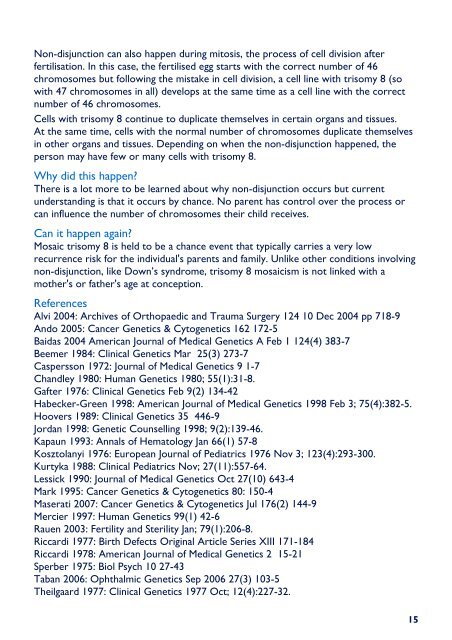Trisomy 8 mosaicism in adults FTNW.pub - Unique - The Rare ...
Trisomy 8 mosaicism in adults FTNW.pub - Unique - The Rare ...
Trisomy 8 mosaicism in adults FTNW.pub - Unique - The Rare ...
You also want an ePaper? Increase the reach of your titles
YUMPU automatically turns print PDFs into web optimized ePapers that Google loves.
Non-disjunction can also happen dur<strong>in</strong>g mitosis, the process of cell division after<br />
fertilisation. In this case, the fertilised egg starts with the correct number of 46<br />
chromosomes but follow<strong>in</strong>g the mistake <strong>in</strong> cell division, a cell l<strong>in</strong>e with trisomy 8 (so<br />
with 47 chromosomes <strong>in</strong> all) develops at the same time as a cell l<strong>in</strong>e with the correct<br />
number of 46 chromosomes.<br />
Cells with trisomy 8 cont<strong>in</strong>ue to duplicate themselves <strong>in</strong> certa<strong>in</strong> organs and tissues.<br />
At the same time, cells with the normal number of chromosomes duplicate themselves<br />
<strong>in</strong> other organs and tissues. Depend<strong>in</strong>g on when the non-disjunction happened, the<br />
person may have few or many cells with trisomy 8.<br />
Why did this happen?<br />
<strong>The</strong>re is a lot more to be learned about why non-disjunction occurs but current<br />
understand<strong>in</strong>g is that it occurs by chance. No parent has control over the process or<br />
can <strong>in</strong>fluence the number of chromosomes their child receives.<br />
Can it happen aga<strong>in</strong>?<br />
Mosaic trisomy 8 is held to be a chance event that typically carries a very low<br />
recurrence risk for the <strong>in</strong>dividual's parents and family. Unlike other conditions <strong>in</strong>volv<strong>in</strong>g<br />
non-disjunction, like Down’s syndrome, trisomy 8 <strong>mosaicism</strong> is not l<strong>in</strong>ked with a<br />
mother's or father's age at conception.<br />
References<br />
Alvi 2004: Archives of Orthopaedic and Trauma Surgery 124 10 Dec 2004 pp 718-9<br />
Ando 2005: Cancer Genetics & Cytogenetics 162 172-5<br />
Baidas 2004 American Journal of Medical Genetics A Feb 1 124(4) 383-7<br />
Beemer 1984: Cl<strong>in</strong>ical Genetics Mar 25(3) 273-7<br />
Caspersson 1972: Journal of Medical Genetics 9 1-7<br />
Chandley 1980: Human Genetics 1980; 55(1):31-8.<br />
Gafter 1976: Cl<strong>in</strong>ical Genetics Feb 9(2) 134-42<br />
Habecker-Green 1998: American Journal of Medical Genetics 1998 Feb 3; 75(4):382-5.<br />
Hoovers 1989: Cl<strong>in</strong>ical Genetics 35 446-9<br />
Jordan 1998: Genetic Counsell<strong>in</strong>g 1998; 9(2):139-46.<br />
Kapaun 1993: Annals of Hematology Jan 66(1) 57-8<br />
Kosztolanyi 1976: European Journal of Pediatrics 1976 Nov 3; 123(4):293-300.<br />
Kurtyka 1988: Cl<strong>in</strong>ical Pediatrics Nov; 27(11):557-64.<br />
Lessick 1990: Journal of Medical Genetics Oct 27(10) 643-4<br />
Mark 1995: Cancer Genetics & Cytogenetics 80: 150-4<br />
Maserati 2007: Cancer Genetics & Cytogenetics Jul 176(2) 144-9<br />
Mercier 1997: Human Genetics 99(1) 42-6<br />
Rauen 2003: Fertility and Sterility Jan; 79(1):206-8.<br />
Riccardi 1977: Birth Defects Orig<strong>in</strong>al Article Series XIII 171-184<br />
Riccardi 1978: American Journal of Medical Genetics 2 15-21<br />
Sperber 1975: Biol Psych 10 27-43<br />
Taban 2006: Ophthalmic Genetics Sep 2006 27(3) 103-5<br />
<strong>The</strong>ilgaard 1977: Cl<strong>in</strong>ical Genetics 1977 Oct; 12(4):227-32.<br />
15

















